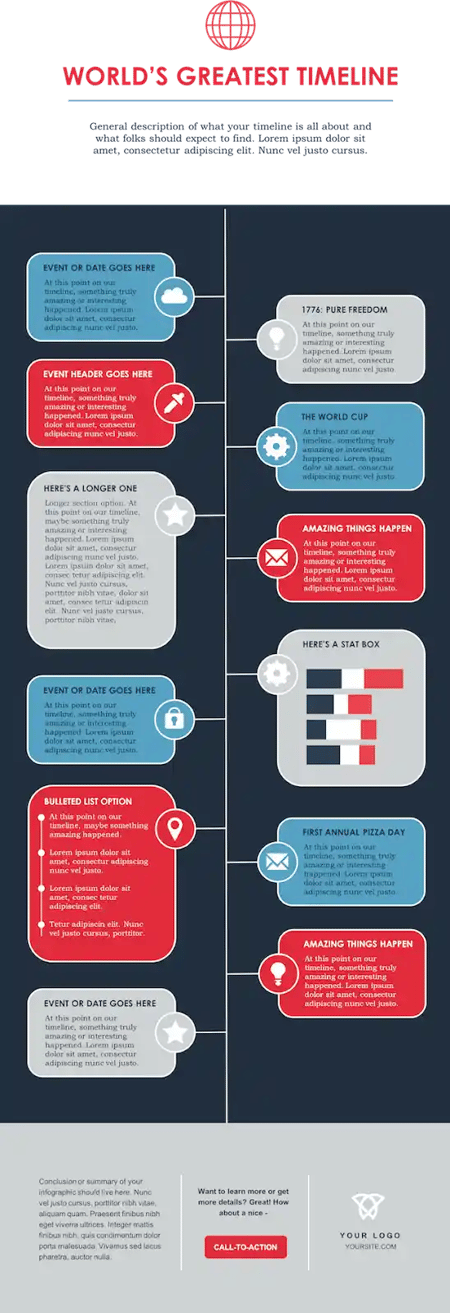Wouldn’t it be great if creating infographics was as simple as writing text-based blog posts? Usually, it would take a lot of time, effort, and skill to make them — but that doesn’t have to be the case.
Considering the popularity and effectiveness of visual content in marketing today, you shouldn’t throw in the towel just yet.

That’s why we decided to do most of the work for you. With HubSpot’s Free Infographic Templates in PowerPoint, you can create high-quality, professional infographics in under an hour.
You can add your own content to premade outlines in a cinch. And if you need a helping hand, we’ll show how to personalize your infographic in PowerPoint in this post. Keep reading to learn how to make a memorable infographic with ease.
If you prefer watching, this video shows the process of creating an infographic, step-by-step:
How to Make an Infographic
- Choose your desired infographic template.
- Decide on a goal for your infographic.
- Identify the audience for your infographic.
- Collect your content and relevant data.
- Download your template to PowerPoint.
- Customize your infographic.
- Include a footer with your sources and logo.
- Promote and publish your infographic.
1. Choose your desired infographic template.
First things first, you have to choose an infographic template appropriate for representing that data.
The important thing is to choose a template that specifically works for the type of data set/content you want to present.
As you saw pictured above, you can download our 15 infographic templates in PowerPoint and choose whichever template you’d like.
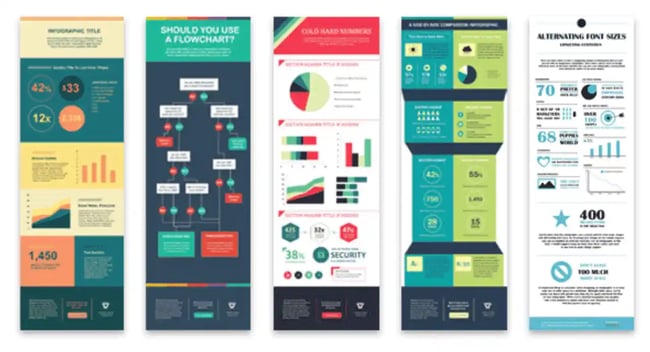
Download for Free
Choosing a template before creating a goal for your infographic can speed up your infographic creation process. First, it helps you visualize how you will organize and present your data. This can help you narrow your focus before you get into designing your infographic.
Next, infographic templates have premade sections or modules to help you structure your content. This makes it easy to understand how your information will fit within each section to give your infographic a logical flow and helps you create a better audience experience.
Starting with a template can also spark creative ideas for your infographic and inspire original ways to tell your visual story.
Other important qualities to consider as you choose a template include:
- Whether your infographic is using quantitative, qualitative, or categorical data
- How complex your data set is
- Whether the infographic design elements align with your brand
- Accessibility, including readability for all audiences
Some of your template options in the offer linked above include a timeline, flowchart, side-by-side comparison, and a data-driven infographic.
Types of Infographics
Here are some basic types of infographics. This list can help you choose an infographic template that suits the story you want your data to tell:
Side-By-Side Comparison Infographic
This infographic design can help prove the advantage of one concept over another, or simply explain the differences between two competing entities.
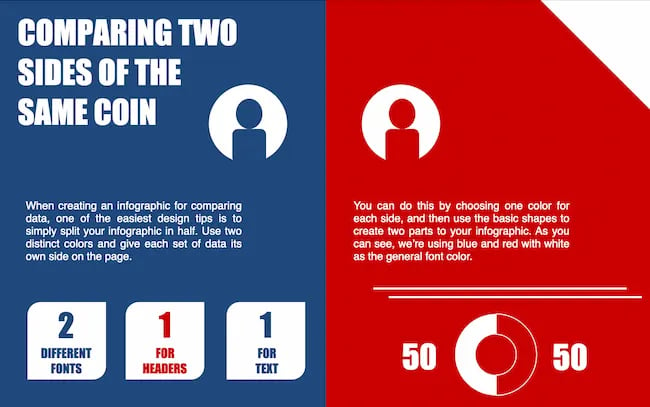 Download this template
Download this template
Flowchart Infographic
This design is perfect for presenting a new workflow for your organization, or how a linear or cyclical process works across your industry.

Download this template
Timeline Infographic
This design can tell a chronological story, or history, of a business, industry, product, or concept.
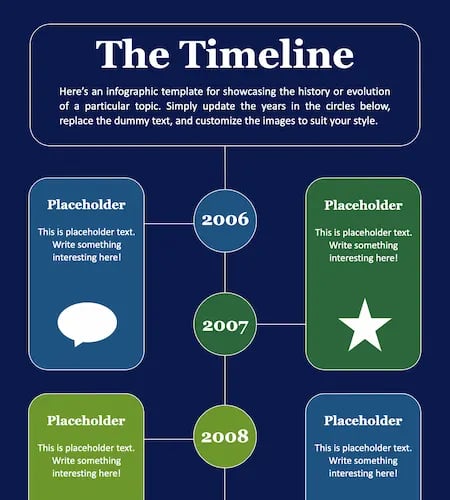
Download this template
Graph-Based Infographic
This design is suitable for content creators publishing a high volume of data and statistical information, making it a good fit for expert-level audiences, too.
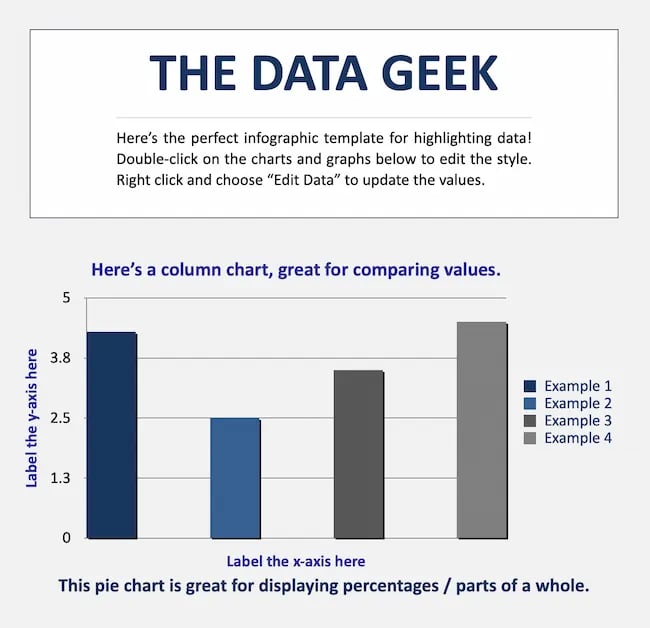
Download this template
Image-Heavy Infographic
This design caters to content creators who are trying to reveal trends and information from shapes, designs, or photography — rather than just numbers and figures.
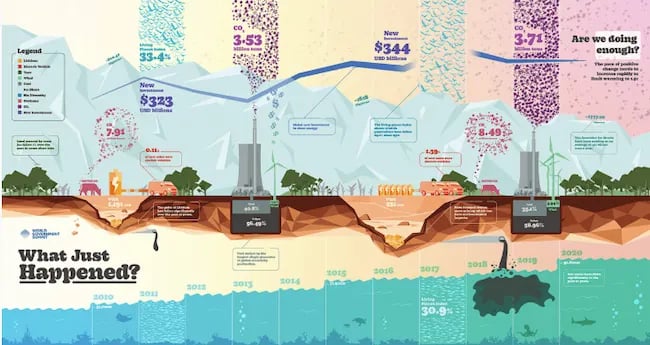
Image Source
Pro tip: Choose a template that offers a range of layout options for different types of information. A template with diverse layouts can help you create more visually engaging and informative infographics.
2. Decide on a goal for your infographic.
Once you have the template you want to use, it’s time to get into the details. Without a clear goal, your infographic may include too much information or fail to convey your message.
Your goal should include the purpose of your infographic. Do you want to educate, persuade, inform, or inspire your audience?
An infographic can help you:
- Quickly summarize complex topics
- Simplify complicated processes
- Highlight research or survey results
- Condense long-form content, like blog posts or case studies
- Analyze and compare different products or concepts
- Boost awareness about a topic
And an infographic is for more than just presenting information. So, your goal should also include a desired action or response you want to elicit from your audience. Do you want them to sign up for a newsletter, visit a website, or take another desired action?
Critically thinking about goals for your infographic helps you align each infographic with larger marketing targets.
3. Identify the audience for your infographic.
Infographics don’t sell themselves on design alone. They’re ultimately about communication. You need to deliver “info” that’s just as compelling as the “graphic,” and to do that, you need to know the audience your infographic intends to reach.
According to Harvard Business Review, five possible audiences can change how you choose and visualize your data: novice, generalist, managerial, expert, and executive. Start by comparing your infographic’s ideal reader with one of these five audiences — which one applies to your reader?
When thinking about the data you want to visualize, let the five audiences above dictate how advanced your data will be. For example:
- A novice audience might need data whose meaning is more obvious at first blush.
- A generalist may want to better understand the big picture of a concept.
- A managerial audience might need to see how different groups or actions affect one another.
- An expert might be more interested in getting into the weeds of your numbers and posing theories around them.
- An executive has more in common with a novice audience in that they only have time for the simplest or most critical information and the impact it’ll have on the business.
Once you’ve identified who your infographic is for, dig deeper into that persona. You should understand what interests that audience, what motivates them, and what specific information they need.
Then, think about how and where they’ll see your infographic. Will it be on a website, shared on social media, or presented at a conference? Can you repurpose sections of your infographic for different channels?
The platform and situation should influence the design and format of your infographic. Keeping these details in mind will make your infographic stand out and make an impact.
Pro tip: Take audience awareness a step further by conducting research or gathering feedback from your target audience. These details make it easier to tailor your infographic to their specific needs.
4. Collect your content and relevant data.
Using the audience you’ve chosen above, your next step is to organize all the content and data you’ll use in the infographic. You can either collect third-party data or use your own original data.
Choose your data.
Compelling data needs to be comprehensive enough to give your readers proper context around the data you’re presenting.
When collecting your data, make sure you know what story you want to tell through this information. Data for the sake of data won’t add value to your infographic at all.
Choose data that’s interesting and gives a good understanding of the topic. You can compare numbers or look at trends over time to tell a story with your data.
For example, a spike in website traffic from one month to the next doesn’t mean much — until, say, you reveal that traffic was on a steady decline over the previous three months. Suddenly you have a story of how you were able to reverse a downward trend.
Organize your data.
Make sure to organize the data in a way that makes sense and tells the story you want to share. Think about what data points are most important and create a structure that emphasizes that data.
For example, you may want to write a quick outline of your data story. Then, match your data points with each relevant section of your outline.
Cite your sources.
If you use third-party data, be sure you properly cite your sources — just like in any other good piece of content.
And, try to keep your infographic uncluttered by a ton of different source URLs. A great way to cite your sources is to include a simple URL at the bottom of your infographic that links to a page on your site.
You can also list the individual stats used in your infographic and their sources on a landing page. Try linking this page to an offer that includes your free infographic.
With these tips, your infographic will look clean and professional and people will be able to access the sources no matter where the infographic gets shared or embedded. It may even drive visitors back to your site.
Pro tip: Think about different types of charts and graphs to present your data. Look for chances to turn complex statistics or concepts into easy-to-understand visualizations.
5. Download your template to PowerPoint.
For the sake of time (remember, our mission is to create an infographic in under an hour), I’m going to create an infographic with PowerPoint.
This is the easiest tool to use because it’s widely accessible software that’s already on most computers, so you can work on your infographic even without an internet connection. The user interface is also familiar and user-friendly, making it easy for beginners.
This example is based on steps and best practices from our guide, How to Create Effective Inbound Marketing Campaigns.
I’ve picked the “World’s Greatest Timeline” infographic template from our collection of infographic templates. This template is best suited for my data set since it will allow me to outline each step of the campaign creation process in chronological order.
If you’re ready to get started, just open the infographic template in PowerPoint. This will create a new presentation based on the selected template. Then you can start customizing.
6. Customize your infographic.
This is the most time-consuming part — plugging in the content you already have. With the right template, this step will go fast. All you need to do is replace the placeholder text and graphics with your own information.
Come up with a catchy title, plug in your data/content, and adjust your font sizes and formatting. Feel free to switch up the graphics and colors, too, so they’re relevant to your brand and the data you’re providing. To customize the look of the infographic even more, you might add or change the colors or font styles to your liking.
In this example, you’ll notice that I’ve inputted my text and changed the font colors to HubSpot’s signature colors:
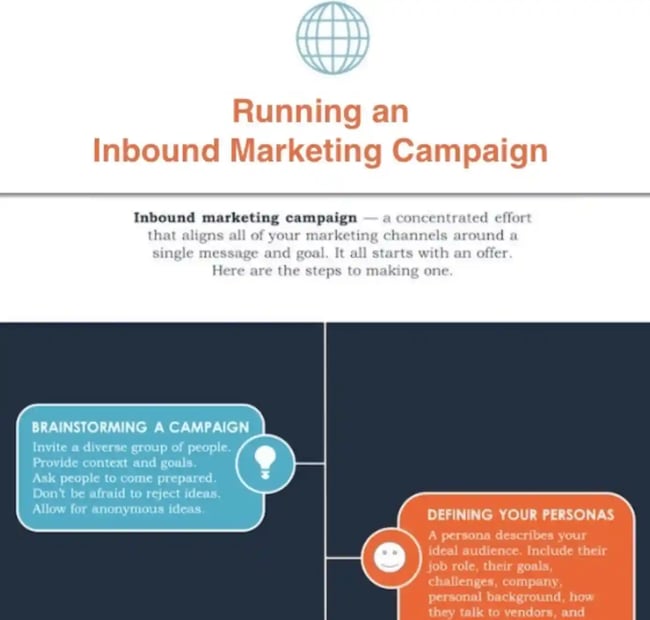
You’re not limited by what the template includes, either. You can use the tools in PowerPoint software to create bar graphs, pie charts, and other visuals to support your data. (Note: Download our free infographic templates for a cheat sheet for using PowerPoint’s various features and tools.)
As you customize, focus on visual hierarchy and readability. Remember, any visuals should support and enhance your data.
Pro tip: Use consistent visual cues such as icons, color schemes, or illustrations. This creates a consistent visual language for your infographic and reinforces your brand. If your business plans to use infographics consistently, think about creating an infographic-specific style guide.
7. Include a footer with your sources and logo.
Finally, include a link to your source (mine is here) and the company logo. This way, people will recognize your content if it gets shared on social media or embedded on other websites.
After all, one of the main benefits of creating infographics is their shareability. These details will also make your infographic feel more credible and authentic.
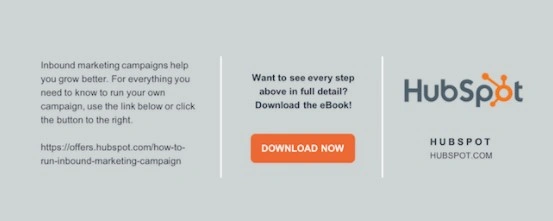
Pro tip: Contributor details or acknowledgments can also boost the trustworthiness of your infographic.
8. Promote and publish your infographic.
The only thing left to do is to publish and promote your awesome new infographic. A few recommendations for promotion:
Publish your infographic on your blog.
Publishing an infographic on a blog improves the visual appeal of your content. It also makes it easier for your audience to understand complex or new concepts, boosts SEO, and drives user engagement. Don’t forget to include your list of sources.
Add a Pinterest button.
This will help visitors easily “pin” your infographic on Pinterest for quick sharing and added exposure. Think about adding a brief description or caption for Pinterest sharing. This increases your chances of engagement and can generate more interest from potential viewers.


Create and add an embed code.
This makes it easy for visitors to share your infographic on their websites, social media platforms, and blogs, as we did below.
Share This Image On Your Site
With the infographic complete and published, that’s a wrap. It won’t take you long to create some impressive infographics of your own once you get started — but before you begin, here are some guidelines you should keep in mind.
Tips for Creating a Great Infographic
1. The information you communicate matters more than its design.
You can make the most visually appealing infographic of the year, but if it doesn’t clearly communicate a purpose or message, then what’s the point?
Not to say that the infographic’s design is unimportant, but the information available on it should always be the priority. A good infographic tells the audience what they need to know, and is given adds more depth or dimension when coupled with a good design.
2. Know who you’re making the infographic for.
Speaking of the audience, you have to know the type of reader that’s looking for the information you have to offer. We already discussed the different types of audiences you write for, but we just wanted to reiterate it once more.
3. Avoid adding clutter to your infographic.
It’s easy to get carried away with icons, graphics, and word art, but if it’s becoming distracting to the reader, then it’s defeating the purpose of the infographic in the first place.
Keep your infographic looking clear and skimmable, the reader shouldn’t have to navigate it like a puzzle to find the information they need.
4. Ensure the visuals add value to your data.
Echoing our last point, the visuals that do make it to your infographic should be there to add value to the data beside it — this is the concept behind information design.
Whether it’s graphs, diagrams, icons, or real-life imagery, it should take the numerical value of information shared and contextualize it. This way there’s an emotional element behind the messaging than just bolding percentages.
5. Test for readability and user experience.
Before you share your infographic, make sure it’s legible and accessible to a wide range of users. Test the font size, color contrast, and readability on different screens and devices. Think about usability factors like navigation and CTAs.
Share Your Professional Infographic Today
This whole thing took me under an hour to put together — much less time (not to mention more professional looking) than it would’ve taken if I’d started from scratch. Plus, it’s less expensive than hiring a designer and using the resources you might want to save for larger campaigns.
Editor’s note: This post was originally published in May 2020 and has been updated for comprehensiveness. This article was written by a human, but our team uses AI in our editorial process. Check out our full disclosure to learn more about how we use AI.
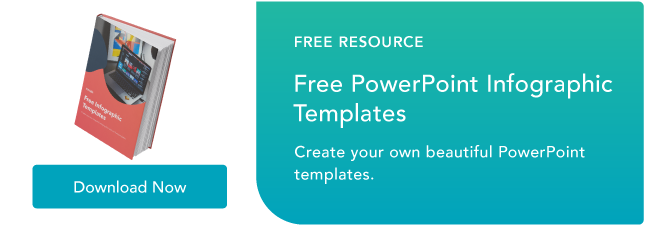
Credit: Source link

![How to Create an Infographic in Under an Hour [+ Free Templates] How to Create an Infographic in Under an Hour [+ Free Templates]](https://blog.hubspot.com/hubfs/infographic-powerpoint-template_5.webp#keepProtocol)
